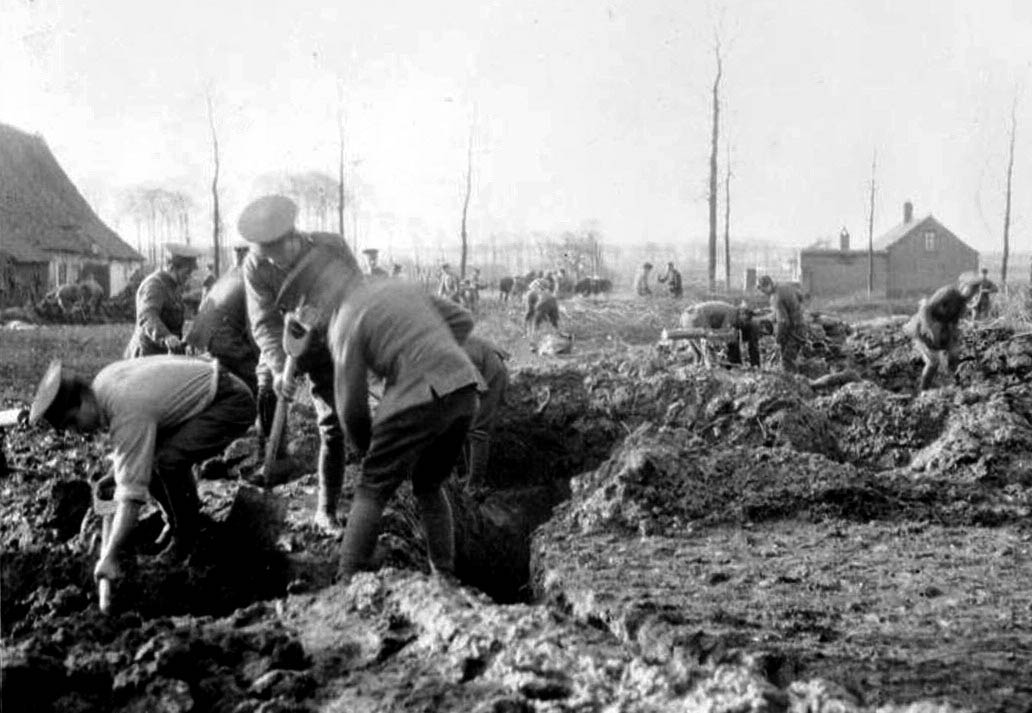
British Soldiers digging in during the Retreat from Mons in which Walter Shimmon who was serving in the 2nd Battalion,
Suffolk Regiment took part.
Walter John Clarke Shimmon was born in Lewisham, London, in November 1877, the son of Sarah Shimmon. In 1881, he was living with his grandparents in Ipswich. Ten years later and Walter was living in Kensington where his mother was working as a lady’s maid.
In July 1896, Walter enlisted in the Territorial Army, joining the Kew platoon of the Royal Artillery. The following year, Walter was discharged from the Territorials and joined the regular army with the 1st Battalion Royal Scots for a period of twelve years; seven under “the Colours” and five in the Reserve.
Walter was soon to be sent over to South Africa and the Boer War. He served there from at least 1899 to 1902, receiving battle honour clasps for Belmont, Modder River, Dreifontain, Johannesburg, Diamond Hill and Belfast, on his Queen Victoria’s South Africa Medal. He was discharged from the army in 1909 and, two years later, he was living with his mother in Mawby Street, London, where he worked as a civil service porter.
Walter’s next job was as an attendant at St Audry’s Hospital and he joined the staff on 16th February 1914. The war, however, was to cut his time there short as, on 14th August 1914, he had joined the 2nd Suffolk Regiment under regular soldier terms. Three days later, he was in France.
The 2nd Suffolks were on the front line almost as soon as they arrived, having been sent to Mons to try and stop the German advance. On 23rd August, Walter and his battalion were on the front line on the Mons-Conde Canal. During the day, the enemy managed to break through the British lines. The battalion was ordered to retreat and, over the next two days, managed to keep one step ahead of the enemy before digging-in half a mile to the west of Le Cateau. On 25th August, the German army attacked once more and the 2nd Battalion, Suffolk Regiment was directly in the path of their advance.
Walter and the battalion held out for nine hours before becoming overwhelmed by the enemy and forced to try to retreat once more. The actions of the 2nd Suffolks and the Yorkshire Light Infantry that day enabled the rest of the British Expeditionary Force to retreat quickly and regroup.
On the 27th August, the battalion reached St Quentin where a roll call revealed they had been reduced to one hundred and eleven men of all ranks from the one thousand that they had started with. This figure was to increase to two hundred and twenty-nine once the men scattered in the confusion of the retreat succeeded in finding their battalion. Walter was one of the men to survive the Battle of Le Cateau and would go on to serve with them until the following year, when he was discharged from the army as “physically unfit for war service.”
Walter returned to Suffolk where he married Ethel Eliza Miller in 1917. They had a daughter, Ethel Mary, in 1918. Walter died on 29th January 1927 while living at 57 Fore Hamlet, in Ipswich. For his war service, Walter received the 1914 Starwith Clasp and Rose, the BritishWar and Victory Medals and the Silver War Badge.
